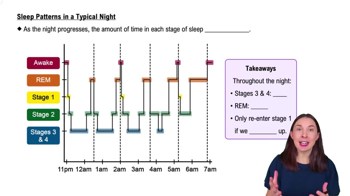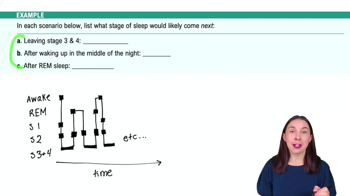Table of contents
- 1. Introduction to Psychology1h 43m
- 2. Psychology Research2h 20m
- 3. Biological Psychology2h 41m
- 4. Sensation and Perception28m
- 5. Consciousness and Sleep32m
- 6. Learning41m
- 7. Memory34m
- 8. Cognition37m
- 9. Emotion and Motivation35m
- 10. Developmental Psychology33m
- 11. Personality48m
- 12. Social Psychology41m
- 13. Stress and Health41m
- 14. Psychological Disorders44m
- 15. Treatment47m
5. Consciousness and Sleep
Sleep
Struggling with Psychology?
Join thousands of students who trust us to help them ace their exams!Watch the first videoMultiple Choice
Many researchers believe that reports of ghostly visions and alien abductions can be explained by _____ during N1 sleep.
A
hypnogogic images
B
heightened consciousness
C
REM rebound
D
divided consciousness
 Verified step by step guidance
Verified step by step guidance1
Understand the context of the problem: The question is about phenomena experienced during a specific sleep stage, N1 sleep, which is the transition from wakefulness to sleep.
Identify the key term: 'hypnogogic images' are vivid visual, auditory, or tactile sensations that occur during the transition from wakefulness to sleep, specifically during N1 sleep.
Consider the other options: 'heightened consciousness' refers to an increased state of awareness, which is not typically associated with sleep. 'REM rebound' is the increase in REM sleep following a period of sleep deprivation, and 'divided consciousness' refers to a state where attention is split between two or more tasks.
Relate the key term to the phenomena: Hypnogogic images can explain ghostly visions and alien abductions because they are vivid and can be mistaken for real experiences during the transition to sleep.
Conclude by matching the correct term: Given the context and definitions, 'hypnogogic images' is the most appropriate explanation for the experiences described during N1 sleep.

 3:25m
3:25mWatch next
Master Circadian Rhythms with a bite sized video explanation from Hannah Gordils
Start learningRelated Videos
Related Practice


































































































![Race, Genes and IQ Differences | Bret Weinstein [Mini Clip]](https://img.youtube.com/vi/IztL_m3pd70/mqdefault.jpg)



































































































